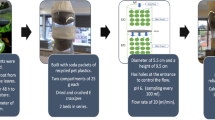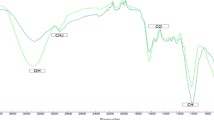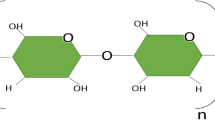Abstract
In recent years, chromium water pollution has become a serious problem for aquatic environments as rivers and wetlands, and for human health. Many researchers are working on finding economic and efficient ways to solve this issue, with the objective of mitigating the damaging effluents of the industries, as in the case of the dumping of chromium. In this study, the removal of chromium (VI) by plant cellulose and bacterial cellulose was evaluated. An experiment was carried out with different initial concentrations of chromium, evaluating the ability to eliminate and adsorb this contaminant by means of biomass of E crassipes, bacterial cellulose, and the union of these two biomasses, determining which is the best biomass. Different design variables such as characterizations of biomasses, adsorption kinetics, adsorption capacities through Langmuir isotherms, pH influence, and desorption-adsorption capacities of each of these biomasses were evaluated. Concluding that the capacity of bacterial cellulose (BC) is 47 mg/g, the capacity between bacterial cellulose and E crassipes cellulose (EC + BC) is 28 mg/g and the cellulose of E crassipes (EC) is 10 mg/g. However, with the biomass of EC was given five processes of treatment more due to the power of elution that had the HCl about the Cr (VI) adhered in this biomass. But with the biomass of BC, the HCl had not the same result of elutions and alone had one treatment of Cr (VI).













Similar content being viewed by others
References
Ammar NS, Elhaes H, Ibrahim HS, Ibrahim MA (2014) A novel structure for removal of pollutants from wastewater. Spectrochim Acta Part A Mol Biomol Spectrosc 121:216–223
Baldikova E, Pospiskova K, Ladakis D, Kookos IK, Koutinas AA, Safarikova M, Safarik I (2017) Magnetically modified bacterial cellulose: a promising carrier for immobilization of affinity ligands, enzymes, and cells. Mater Sci Eng, C 71:214–221
Cao F, Lian C, Yu J, Yang H, Lin S (2019) Study on the adsorption performance and competitive mechanism for heavy metal contaminants removal using novel multi-pore activated carbons derived from recyclable long-root Eichhornia crassipes. Biores Technol 276:211–218
Carreño Pineda LD (2011) Efecto de las Condiciones de Cultivo y Purificación sobre las Propiedades Fisicoquímicas y de Transporte en Membranas de Celulosa Bacteriana (Doctoral dissertation, Universidad Nacional de Colombia)
Carreño Sayago UF, Granada Torres CA (2017) Design, development, and evaluation of a laboratory-scale phytoremediation system using eichhornia crassipes for the treatment of chromium-contaminated waters. Tecciencia 12(22):7–14
Chen X, Cui J, Xu X, Sun B, Zhang L, Dong W, Sun D (2020) Bacterial cellulose/attapulgite magnetic composites as an efficient adsorbent for heavy metal ions and dye treatment. Carbohyd Polym 229:115512
Cheng Z, Yang R, Liu X, Liu X, Chen H (2017) Green synthesis of bacterial cellulose via acetic acid pre-hydrolysis liquor of agricultural corn stalk used as carbon source. Biores Technol 234:8–14
Condon JB (2019) Surface Area and Porosity Determinations by Physisorption: Measurement. Elsevier, Classical Theories and Quantum Theory
Dautoo UK, Shandil Y, Chauhan GS (2017) New crosslinked hydrazide–based polymers as Cr (VI) ions adsorbents. J Environ Chem Eng 5(6):5815–5826
de Souza SS, Berti FV, de Oliveira KP, Pittella CQ, de Castro JV, Pelissari C, Porto LM (2019) Nanocellulose biosynthesis by komagataeibacter hansenii in a defined minimal culture medium. Cellulose 26(3):1641–1655
El-Zawahry MM, Abdelghaffar F, Abdelghaffar RA, Hassabo AG (2016) Equilibrium and kinetic models on the adsorption of reactive black 5 from aqueous solution using Eichhornia crassipes/chitosan composite. Carbohyd Polym 136:507–515
Gazi M, Oladipo AA, Azalok KA (2018) Highly efficient and magnetically separable palm seed-based biochar for the removal of nickel. Sep Sci Technol 53(7):1124–1131
Gong X, Huang D, Liu Y, Zeng G, Wang R, Wan J, Xue W (2017) Stabilized nanoscale zerovalent iron mediated cadmium accumulation and oxidative damage of Boehmeria nivea (L.) Gaudich cultivated in cadmium contaminated sediments. Environ Sci Technol 51(19):11308–11316
Gupta A, Balomajumder C (2015) Removal of Cr (VI) and phenol using water hyacinth from single and binary solution in the artificial photosynthesis chamber. J Water Process Eng 7:74–82
Hokkanen S, Repo E, Sillanpää M (2013) Removal of heavy metals from aqueous solutions by succinic anhydride modified mercerized nanocellulose. Chem Eng J 223:40–47
Hokkanen S, Repo E, Suopajärvi T, Liimatainen H, Niinimaa J, Sillanpää M (2014a) Adsorption of Ni (II), Cu (II) and Cd (II) from aqueous solutions by amino modified nanostructured microfibrillated cellulose. Cellulose 21(3):1471–1487
Hokkanen S, Repo E, Westholm LJ, Lou S, Sainio T, Sillanpää M (2014b) Adsorption of Ni2+, Cd2+, PO43− and NO3− from aqueous solutions by nanostructured microfibrillated cellulose modified with carbonated hydroxyapatite. Chem Eng J 252:64–74
Hokkanen S, Bhatnagar A, Sillanpää M (2016) A review on modification methods to cellulose-based adsorbents to improve adsorption capacity. Water Res 91:156–173
Huang SH, Chen DH (2009) Rapid removal of heavy metal cations and anions from aqueous solutions by an amino-functionalized magnetic nano-adsorbent. J Hazard Mater 163(1):174–179
Huang X, Hu J, Qin F, Quan W, Cao R, Fan M, Wu X (2017) Heavy metal pollution and ecological assessment around the Jinsha coal-fired power plant (China). Int J Environ Res Publ Health 14(12):1589
Huang X, Zhan X, Wen C, Xu F, Luo L (2018) Amino-functionalized magnetic bacterial cellulose/activated carbon composite for Pb2+ and methyl orange sorption from aqueous solution. J Mater Sci Technol 34(5):855–863
Huang D, Liu C, Zhang C, Deng R, Wang R, Xue W, Guo X (2019) Cr (VI) removal from aqueous solution using biochar modified with Mg/Al-layered double hydroxide intercalated with ethylenediaminetetraacetic acid. Biores Technol 276:127–132
Iváñez M (2017) Diseño de un sistema de adsorción para la eliminación de fenol presente en disolución acuosa (Doctoral dissertation)
Jin X, Xiang Z, Liu Q, Chen Y, Lu F (2017) Polyethyleneimine-bacterial cellulose bioadsorbent for effective removal of copper and lead ions from aqueous solution. Biores Technol 244:844–849
Kamarudin NSB, Rahman NA, Kalil SM, Kamarudin SK (2018) Comparative study of bio-cellulose from Acetobacter Xylinum 0416 and commercial hard gelatine capsule. Int J Appl Eng Res 13(1):743–748
Kobielska PA, Howarth AJ, Farha OK, Nayak S (2018) Metal–organic frameworks for heavy metal removal from water. Coord Chem Rev 358:92–107
Komy ZR, Abdelraheem WH, Ismail NM (2013) Biosorption of Cu2+ by Eichhornia crassipes: physicochemical characterization, biosorption modeling and mechanism. J King Saud Univ Sci 25(1):47–56
Kumar V, Sharma DK, Bansal V, Mehta D, Sangwan RS, Yadav SK (2019) Efficient and economic process for the production of bacterial cellulose from isolated strain of Acetobacter pasteurianus of RSV-4 bacterium. Bioresource Technol 275:430–433
Li X, Liu S, Na Z, Lu D, Liu Z (2013) Adsorption, concentration, and recovery of aqueous heavy metal ions with the root powder of Eichhornia crassipes. Ecol Eng 60:160–166
Lin S, Yang H, Na Z, Lin K (2018) A novel biodegradable arsenic adsorbent by immobilization of iron oxyhydroxide (FeOOH) on the root powder of long-root Eichhornia crassipes. Chemosphere 192:258–266
Lin S, Huang W, Yang H, Sun S, Yu J (2020) Recycling application of waste long-root Eichhornia crassipes in the heavy metal removal using oxidized biochar derived as adsorbents. Bioresour Technol 314:123749
Min LU, Zhang YM, Guan XH, Xu XH, Gao TT (2014) Thermodynamics and kinetics of adsorption for heavy metal ions from aqueous solutions onto surface amino-bacterial cellulose. Trans Nonferrous Met Soc China 24(6):1912–1917
Mohammed N, Grishkewich N, Tam KC (2018) Cellulose nanomaterials: promising sustainable nanomaterials for application in water/wastewater treatment processes. Environ Sci Nano 5(3):623–658
Muhamad, I. I., Muhamad, S. N. H., Salehudin, M. H., Zahan, K. A., Tong, W. Y., & Pa'e, N. (2020). Effect of pandan extract concentration to chromium (IV) removal using bacterial cellulose-pandan composites prepared by in-situ modification technique. Materials Today: Proceedings.
Niu Y, Li K, Ying D, Wang Y, Jia J (2017) Novel recyclable adsorbent for the removal of copper (II) and lead (II) from aqueous solution. Biores Technol 229:63–68
Oladipo AA, Adeleye OJ, Oladipo AS, Aleshinloye AO (2017) Bio-derived MgO nanopowders for BOD and COD reduction from tannery wastewater. J Water Process Eng 16:142–148
Oladipo AA, Ahaka EO, Gazi M (2019) High adsorptive potential of calcined magnetic biochar derived from banana peels for Cu 2+, Hg 2+, and Zn 2+ ions removal in single and ternary systems. Environ Sci Pollut Res 26(31):31887–31899
Phruksaphithak, N., Kaewnun, C., & Sompong, O. (2019). Bacterial cellulose production and applications. Science, Engineering and Health Studies (FORMER NAME" SILPAKORN UNIVERSITY SCIENCE AND TECHNOLOGY JOURNAL"), 13(1), 1–7.
Pillai SS, Deepa B, Abraham E, Girija N, Geetha P, Jacob L, Koshy M (2013) Biosorption of Cd (II) from aqueous solution using xanthated nano banana cellulose: equilibrium and kinetic studies. Ecotoxicol Environ Saf 98:352–360
Rice, E. W., Baird, R. B., & Eaton, A. D. (2017). Standard Methods for the Examination of Water and Wastewater, 23rd Edition (23rd ed.). American Water Works Association.
Ruan C, Strømme M, Lindh J (2016) A green and simple method for preparation of an efficient palladium adsorbent based on cysteine functionalized 2, 3-dialdehyde cellulose. Cellulose 23(4):2627–2638
Saman N, Johari K, Song ST, Kong H, Cheu SC, Mat H (2017) High removal efficacy of Hg (II) and MeHg (II) ions from aqueous solution by organoalkoxysilane-grafted lignocellulosic waste biomass. Chemosphere 171:19–30
Sayago UFC (2019) Design of a sustainable development process between phytoremediation and production of bioethanol with Eichhornia crassipes. Environ Monit Assess 191(4):221
Sayago UFC, Castro YP, Rivera LRC et al (2020) Estimation of equilibrium times and maximum capacity of adsorption of heavy metals by E. crassipes (review). Environ Monit Assess 192:141 (2020). https://doi.org/10.1007/s10661-019-8032-9
Sayago UFC (2021) Design and development of a biotreatment of E. crassipes for the decontamination of water with Chromium (VI). Sci Rep 11:9326. https://doi.org/10.1038/s41598-021-88261-0
Shalaby, E. A., Ragab, A. A., Mahmoud, G. I., Shanab, S. M., Monsef, W. S., Fattah, O. A. E., & Ghoneim, A. E. (2019). Enhancement the removal capacity of heavy metals from aqueous solution using different aquatic organisms.
Song C, Zhao Y, Pan D, Wang S, Wu D, Wang L, Hao J, Wei Z (2021) Heavy metals passivation driven by the interaction of organic fractions and functional bacteria during biochar/montmorillonite-amended composting. Bioresource Technol 329:124923
Stoica-Guzun A, Stroescu M, Jinga SI, Mihalache N, Botez A, Matei C, Berger D, Damian CM, Ionita V (2016) Box-Behnken experimental design for chromium (VI) ions removal by bacterial cellulose-magnetite composites. Int J Biol Macromol 91:1062–1072
Sulaiman, N. N., Abd Rahman, N., & Esa, F. (2018). Monitoring Production of Bacterial Cellulose by Acetobacter xylinum 0416 with Fuzzy Logic via Simulation. Jurnal kejuruteraan, 1(7).
Tabinda, A. B., Arif, R. A., Yasar, A., Baqir, M., Rasheed, R., Mahmood, A., & Iqbal, A. (2019). Treatment of textile effluents with Pistia stratiotes, Eichhornia crassipes and Oedogonium sp. International journal of phytoremediation, 1–5.
Tan J, Yang G, Mao J, Dai H (2014) Laboratory study on high-temperature adsorption of HCl by dry-injection of Ca (OH)2 in a dual-layer granular bed filter. Front Environ Sci Eng 8(6):863-870
Wang J, Lu X, Ng PF, Lee KI, Fei B, Xin JH, Wu JY (2015) Polyethylenimine coated bacterial cellulose nanofiber membrane and application as adsorbent and catalyst. J Colloid Interface Sci 440:32–38
Wang C, Wang H, Gu G (2018) Ultrasound-assisted xanthation of cellulose from lignocellulosic biomass optimized by response surface methodology for Pb (II) sorption. Carbohyd Polym 182:21–28
Wei Y, Fang Z, Zheng L, Tsang EP (2017) Biosynthesized iron nanoparticles in aqueous extracts of Eichhornia crassipes and its mechanism in the hexavalent chromium removal. Appl Surf Sci 399:322–329
Worch E (2012) Adsorption technology in water treatment: fundamentals, processes, and modeling. Walter de Gruyter
Xiang Z, Gao W, Chen L, Lan W, Zhu JY, Runge T (2016) A comparison of cellulose nanofibrils produced from Cladophora glomerata algae and bleached eucalyptus pulp. Cellulose 23(1):493–503
Xiang Z, Liu Q, Chen Y, Lu F (2017) Effects of physical and chemical structures of bacterial cellulose on its enhancement to paper physical properties. Cellulose 24(8):3513–3523
Yi ZJ, Yao J, Chen HL, Wang F, Yuan ZM, Liu X (2016) Uranium biosorption from aqueous solution onto Eichhornia crassipes. J Environ Radioact 154:43–51
Yu X, Tong S, Ge M, Wu L, Zuo J, Cao C, Song W (2013) Adsorption of heavy metal ions from aqueous solution by carboxylated cellulose nanocrystals. J Environ Sci 25(5):933–943
Zhang W, Wang XC, Li XY, Jiang F (2020) A 3D porous microsphere with multistage structure and component based on bacterial cellulose and collagen for bone tissue engineering. Carbohydr Poly 236:116043
Zhou W, Ge X, Zhu D, Langdon A, Deng L, Hua Y, Zhao J (2011) Metal adsorption by quasi cellulose xanthogenates derived from aquatic and terrestrial plant materials. Biores Technol 102(3):3629–3631
Zhou Y, Fu S, Zhang L, Zhan H, Levit MV (2014) Use of carboxylated cellulose nanofibrils-filled magnetic chitosan hydrogel beads as adsorbents for Pb (II). Carbohyd Polym 101:75–82
Acknowledgements
To the Fundation University Libertadores.
Funding
About of researcher project, the university “Los Libertadores” is the company that contribute to development of this article and other process.
Author information
Authors and Affiliations
Contributions
UC analyzed and interpreted the used of FTIR and also the process of adsorptions with the design of composites of biomass. YP Evaluated the result of adsorptions and design the experiment of the projects. “All authors read and approved the final manuscript."
Corresponding author
Ethics declarations
Conflict of interest
"The authors declare that they have no competing interests".
Additional information
Editorial responsibility: Samareh Mirkia.
Rights and permissions
About this article
Cite this article
Sayago, U.F.C., Castro, Y.P. Development of a composite material between bacterial cellulose and E crassipes, for the treatment of water contaminated by chromium (VI). Int. J. Environ. Sci. Technol. 19, 6285–6298 (2022). https://doi.org/10.1007/s13762-021-03581-y
Received:
Revised:
Accepted:
Published:
Issue Date:
DOI: https://doi.org/10.1007/s13762-021-03581-y




